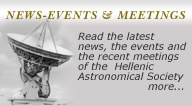| MARCH 2023 - TOPICS |
| |
- Short News
- Job Opportunities in Greece
- e-newsletter of Hel.A.S.: 25 years and counting!
- The 16th Conference of Hel.A.S.
- Monthly Colloquium of Hel.A.S.
- Upcoming Astronomy Meetings in Greece
- About this Newsletter
|
| 1. Short News |
|
We would like to congratulate Dr. Ioannis Myserlis who recently became staff astronomer at Instituto de Radioastronomía Milimétrica (IRAM) in Granada, Spain. The Society extends its best wishes for further success in his professional pursuits.
We would like to congratulate Dr. Chrysa Avdellidou who was recently awarded a faculty position at the Dept. of Physics and Astronomy at the University of Leicester (UK). The Society extends its best wishes for further success in her professional pursuits.
We would like to congratulate Prof. Vassilis Charmandaris who was recently reelected for his second term as the Director of the Institute of Astrophysics - FORTH. The Society extends its best wishes for further success in his professional pursuits.
Even though the deadline for the Hel.A.S. travel grants for meetings occurring during the first half of 2023 has passed, we invite again our junior members to submit their applications for financial support till the end of March. Priority will be given to junior members who have no access to other sources of funding for their participation in conferences or workshops that are deemed paramount for the completion of their PhD Thesis. The application form is available here.
|
| |
2. Job Opportunities in Greece
|
|
One (1) promotion-related position in the area of "Observational Astrophysics" at the level of Researcher B, has opened at the Institute of Astrophysics - FORTH. Interested individuals are invited to submit all the required supporting documents electronically through the information system APELLA (code APP32225) at the web address https://apella.minedu.gov.gr. More information is available here. The application deadline is March 24, 2023.
|
| |
| 3. e-newsletters of Hel.A.S.: 25 years and counting! |
|
As we all read the 301st newsletter of the Society, it is interesting to consider that it has been twenty five years since the first e-newsletter of the Society was mailed by the late Prof. J. Seiradakis, the Secretary of the Society at the time. In the early morning hours of February 27, 1998, he pressed the "Send button" in his computer, starting a tradition which has been kept alive on a monthly basis from the all subsequent Secretaries of the Society. This simple message, the e-newsletter which was sent diligently on the 1st of every month has contributed in its own way in bringing us all a bit closer. You may view the contents of the message here.
Moreover, since the current President of the Society was also involved in preparing the first message, and he has the habit not to delete emails, you can inspect the header of that message, as it was received an hour later by a mail server of Paris Observatory.
From elaset@astro.auth.gr Fri Feb 27 04:04:52 1998
Return-Path:
|
| |
| 4. The 16th Conference of Hel.A.S. |
|
We would like to inform all members that the registration and abstract submission for the 16th Conference of HelAS is open. All members are encouraged to visit the web site of the conference at: https://helas.gr/conf/2023
|
| |
| 5. Monthly Colloquium of Hel.A.S. |
|
We are happy to announce that the March 2023 colloquium speaker is Dr. Chrysa Avdellidou. As usual, videos of all past colloquia are available in the Youtube channel of the Society. Details of the upcoming colloquium follow:
24th Monthly Colloquium of Hel.A.S. - 14 March 2023
"Meteorites that built Earth reveal the early stages of the evolution of our solar system."
by
Dr. Chrysa Avdellidou, (Observatoire de la Côte d’Azur, France)
Tuesday, 14 March 2023 at 15:00 Athens time (UTC + 2:00)
Click for ZOOM link
(Meeting ID: 870 5244 8204 and Passcode: 557407)
Abstract: The identification of meteorite parent bodies provides the context for understanding planetesimal formation and evolution as well as the key Solar System events they have witnessed. However, identifying such links has proven challenging and some appear ambiguous. We identified that the a family of asteroid fragments that is located in the inner main belt is the unique source of the rare EL enstatite chondrite meteorites, the closest meteorites to Earth in terms of their isotopic ratios. This family was created by the collisional fragmentation of a parent body 3 Gyr ago. We calculated that the diameter of the family progenitor was much smaller than the putative size of the EL original planetesimal. Therefore, we deduced that the EL planetesimal that accreted in the terrestrial planet region underwent a first catastrophic collision in that region. Then, at least a fragment of it was transferred and implanted into the main asteroid belt by a dynamical process, where it suffered a more recent catastrophic collision, generating the current source of the EL meteorites.
We investigated all the possible dynamical scenarios under which terrestrial planetesimals or fragments of them could populate the asteroid belt. We concluded that the only capable mechanism is the so-called giant planet instability and this observational study allowed us to date this instability in a narrow time interval.
|
|
| |
| 6. Upcoming Astronomy Meetings in Greece |
|
|
| |
| 7. About this Newsletter |
|
This Newsletter was sent to all members of Hel.A.S. who have e-mail access. The next edition of the Newsletter will be mailed around April 1, 2023. Please send your announcements (e.g., appointments / departures, job openings, research opportunities, awards, conferences in Greece) or comments before March 25, 2023. If you do not wish to receive future issues of this Newsletter or the e-mail address to which it was sent is not your preferred one, please inform the Secretary of Hel.A.S. at secretary@helas.gr.
|








